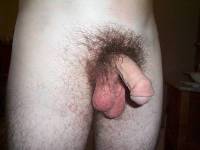Chordee
Editor-In-Chief: Prab R Tumpati, MD
Obesity, Sleep & Internal medicine
Founder, WikiMD Wellnesspedia &
W8MD medical weight loss NYC and sleep center NYC
| Chordee | |
|---|---|

| |
| Synonyms | N/A |
| Pronounce | N/A |
| Specialty | N/A |
| Symptoms | Penile curvature |
| Complications | Erectile dysfunction, urinary tract infection |
| Onset | Congenital |
| Duration | Lifelong if untreated |
| Types | N/A |
| Causes | Congenital malformation, hypospadias |
| Risks | Genetic factors, hormonal imbalances |
| Diagnosis | Physical examination, imaging studies |
| Differential diagnosis | Peyronie's disease, epispadias |
| Prevention | N/A |
| Treatment | Surgical correction |
| Medication | None specific |
| Prognosis | Good with treatment |
| Frequency | Rare |
| Deaths | N/A |
== Chordee ==
Chordee is a medical condition characterized by a downward curvature of the penis, typically evident during an erection. This condition is often associated with hypospadias, a congenital defect where the opening of the urethra is located on the underside of the penis rather than at the tip.
Causes[edit | edit source]
Chordee can be caused by several factors, including:
- Congenital abnormalities: Chordee is often present at birth and may be associated with other congenital conditions such as hypospadias.
- Scar tissue: The presence of fibrous tissue can cause the penis to curve.
- Trauma: Injury to the penis can result in scar tissue formation, leading to chordee.
- Peyronie's disease: This condition involves the development of fibrous plaques within the penile tissue, causing curvature.
Symptoms[edit | edit source]
The primary symptom of chordee is the noticeable curvature of the penis, particularly during an erection. Other symptoms may include:
- Difficulty with sexual intercourse
- Pain during erections
- Psychological distress due to the appearance of the penis
Diagnosis[edit | edit source]
Diagnosis of chordee typically involves a physical examination by a healthcare provider. In some cases, imaging studies such as ultrasound or magnetic resonance imaging (MRI) may be used to assess the extent of the curvature and identify any underlying causes.
Treatment[edit | edit source]
Treatment for chordee depends on the severity of the condition and the presence of associated abnormalities such as hypospadias. Options include:
- Surgical correction: Surgery is often required to straighten the penis and correct any associated abnormalities. This may involve the release of fibrous tissue, grafting, or other reconstructive techniques.
- Non-surgical methods: In mild cases, non-surgical methods such as penile traction therapy may be considered.
Prognosis[edit | edit source]
The prognosis for individuals with chordee is generally good, especially when the condition is treated surgically. Most patients experience significant improvement in penile curvature and function following treatment.
See also[edit | edit source]
References[edit | edit source]
External links[edit | edit source]
Search WikiMD
Ad.Tired of being Overweight? Try W8MD's physician weight loss program.
Semaglutide (Ozempic / Wegovy and Tirzepatide (Mounjaro / Zepbound) available.
Advertise on WikiMD
|
WikiMD's Wellness Encyclopedia |
| Let Food Be Thy Medicine Medicine Thy Food - Hippocrates |
Translate this page: - East Asian
中文,
日本,
한국어,
South Asian
हिन्दी,
தமிழ்,
తెలుగు,
Urdu,
ಕನ್ನಡ,
Southeast Asian
Indonesian,
Vietnamese,
Thai,
မြန်မာဘာသာ,
বাংলা
European
español,
Deutsch,
français,
Greek,
português do Brasil,
polski,
română,
русский,
Nederlands,
norsk,
svenska,
suomi,
Italian
Middle Eastern & African
عربى,
Turkish,
Persian,
Hebrew,
Afrikaans,
isiZulu,
Kiswahili,
Other
Bulgarian,
Hungarian,
Czech,
Swedish,
മലയാളം,
मराठी,
ਪੰਜਾਬੀ,
ગુજરાતી,
Portuguese,
Ukrainian
Medical Disclaimer: WikiMD is not a substitute for professional medical advice. The information on WikiMD is provided as an information resource only, may be incorrect, outdated or misleading, and is not to be used or relied on for any diagnostic or treatment purposes. Please consult your health care provider before making any healthcare decisions or for guidance about a specific medical condition. WikiMD expressly disclaims responsibility, and shall have no liability, for any damages, loss, injury, or liability whatsoever suffered as a result of your reliance on the information contained in this site. By visiting this site you agree to the foregoing terms and conditions, which may from time to time be changed or supplemented by WikiMD. If you do not agree to the foregoing terms and conditions, you should not enter or use this site. See full disclaimer.
Credits:Most images are courtesy of Wikimedia commons, and templates, categories Wikipedia, licensed under CC BY SA or similar.
Contributors: Prab R. Tumpati, MD

